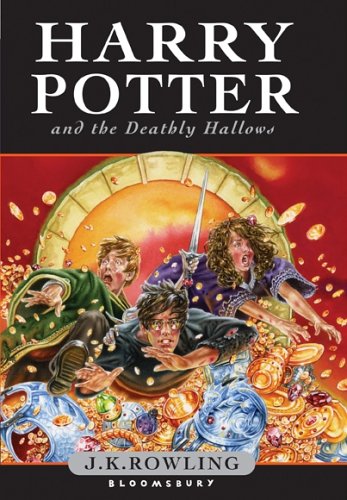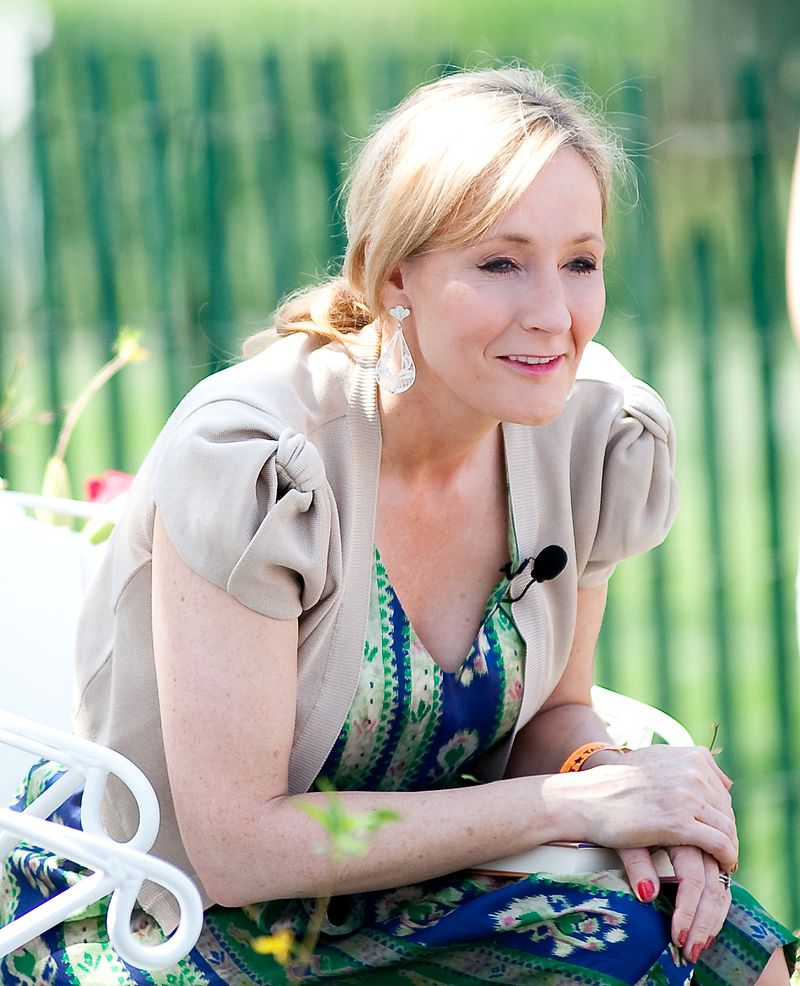Title of the work
Country of the First Edition
Country/countries of popularity
Original Language
First Edition Date
First Edition Details
J. K. Rowling, Harry Potter and the Deathly Hallows. London: Bloomsbury, 2007, 607 pp.
ISBN
Awards
2007 – Newsweek Best Book of the Year;
2007 – New York Times 100 Notable Books and Notable Children's Book;
2007 – Publisher's Weekly Best Books of 2007;
2007 – Andre Norton Award for Young Adult Science Fiction and Fantasy at the Nebula Awards;
2008 – American Library Association Best Book for Young Adults;
2008 – Colorado Bruce Spruce Award.
Source: siue.edu (accessed: June 14, 2021).
Genre
Fantasy fiction
School story*
Target Audience
Crossover
Cover

Cover of the first edition. Courtesy of Bloomsbury Publishing.
Author of the Entry:
Anna Mik, University of Warsaw, anna.m.mik@gmail.com
Peer-reviewer of the Entry:
Elżbieta Olechowska, University of Warsaw, elzbieta.olechowska@gmail.com
Daniel A. Nkemleke, University of Yaoundé 1, nkemlekedan@yahoo.com

Portrait of J. K. Rowling, photographed by Daniel Ogren on April 5, 2010. The file is licensed under the Creative Commons Attribution-Share Alike (accessed: May 25, 2018).
J. K. Rowling
, b. 1965
(Author, Illustrator)
Joanne Kathleen Rowling, was born July 31, 1965 in Yate, Gloucestershire, England. She graduated from the University of Exeter with a degree in French and Classics, she is considered a writer with classical background. After publishing the first Harry Potter book in 1997, she gradually became the best known author of all time.
The Harry Potter septology (1997–2007), is one of the most successful and popular series in the history of children’s literature (Harry Potter and the Philosopher’s Stone sold in 107 million copies). It may be argued that, from the very beginning, the author herself had to expand this world, fill the gaps, and explain all the rules– not only by discussing some issues (later on – mainly on Twitter) or giving guidelines in the interviews but by creating her website Pottermore. Once it was an online platform, where fans could read the series simultaneously with Rowling’s commentary and additions. Now it serves more as commercial space, although Rowling still adds some new elements (e. g. the short history of magical schools in USA).
To give to the devoted fans of Harry something that would allow them to feel the magical bond with the world they want to be a part of she created three books that now exist in both the secondary world of Hogwarts and the primary world where the reader can have a copy in their own hands.
HP Series Spin-offs:
Quidditch Through the Ages by Kennilworthy Whisp (2001), Fantastic Beasts and Where to Find Them by Newton Scamander (2001) and The Tales of Beedle the Bard (2007)* are allegedly copies of books from the world of Harry Potter which include different literary genres and publication formats: history of sport, bestiaries, and collections of fairy tales. These books are not part of the septology, but they provide complementary information about sports, animals and animal-like creatures, and fairy-tales of the Wizarding World. Additionally, they can be interpreted as a device to help convince readers of the reality of the magical world. In these three books, as in the series sensu stricto, J. K. Rowling plays on various levels with great literary traditions, using one of the many features of postmodern literature.
Bio prepared by Anna Mik, University of Warsaw, anna.m.mik@gmail.com
* Hand-written copies were released in 2007, printed ones in 2008.
Adaptations
Movie adaptation:
Dir. David Yates, Harry Potter and the Deathly Hallows, Warner Bros. Pictures, 2010 – part 1, 2011 – part 2.
Video game based on the novel and the movie:
Harry Potter and the Deathly Hallows, published by Electronic Arts, composer: James Hannigan, 2010 – part 1, 2011 – part 2.
Translation
Multiple languages
Sequels, Prequels and Spin-offs
Previous book: Harry Potter (Series, Book 6): Harry Potter and the Half-Blood Prince.
Summary
The seventh and final book in the “Harry Potter” series, Harry Potter and the Deathly Hallows, completes the story of the protagonist's struggle with his lifelong enemy, Lord Voldemort. Harry, Ron and Hermione set off on a journey to find the remaining horcruxes (special objects containing parts of Voldemort's soul and ensuring his immortality). The three friends must constantly hide, pursued by the Dark Lord's followers. The headmaster of Hogwarts is now Snape, a supposed follower of Voldemort, in reality someone who protects Harry, out of love for his mother, Lily. To destroy the horcruxes, the young wizards must return to the school and recover the Basilisk's fangs from the Chamber of Secrets. It is thanks to their venom that the objects with the Dark Lord's soul can be destroyed and he himself defeated. At the end of the novel, a great battle takes place at Hogwarts, involving not only wizards and witches, but also other creatures, for example, trolls or giants.
During the search for horcruxes, they also uncover the secret of the deathly hallows. According to the fairy tale, these three magical objects were once given to three Peverell brothers by Death. The objects were the Elder Wand, the Cloak of Invisibility, and the Resurrection Stone. Harry Potter comes into possession of these three powerful objects and they help him defeat the Dark Lord.
Analysis
In this part of the series we do not encounter any new plot developments based on the ancient tradition (the spells, characters, and some of their names are inspired by antiquity, but most of the motifs have already been discussed in the entries for the previous parts). However, there is a crucial reference - meaningful not only for this part, but for the whole series – a quote serving as an epigraph to the story.
Harry Potter and the Deathly Hallows opens in fact with two quotations – one from Aeschylus, the other from William Penn. The epigraph from The Libation Bearers (446–475) goes as follows in Robert Fagles' 1975 translation:
"Oh, the torment bred in the race,
the grinding scream of death
and the stroke that hits the vein,
the haemorrhage none can staunch, the grief,
the curse no man can bear.
But there is a cure in the house
and not outside it, no,
not from others but from them,
their bloody strife. We sing to you,
dark gods beneath the earth.
Now hear, you blissful powers underground -
answer the call, send help.
Bless the children, give them triumph now."
This is a fragment from the second play of the "Oresteia" trilogy. The Libation Bearers are women carrying beverages to the grave of Agamemnon, murdered by his own wife, Clytemnestra. "Children" in the quote are Orestes and Electra, son and daughter of Agamemnon and Clytemnestra, who plot to kill their mother to avenge their father.
There could be various interpretations of these verses, but two motifs are bound to feature in each: death and children as heroes of great history. In the quoted passage, the enormous burden that death carries is highlighted – both in antiquity and in the 21st century. Death is a phenomenon that belongs to a higher order and only prayers may tame it. This is closely related to the motif of the deathly hallows, which give the power over death, but only if these items are gathered in the hands of one owner. Harry Potter is the first and last such person – at the end of the novel, he breaks the Elder Wand so that no one could ever again attempt to control death.
The second theme that emerges from the quote is childhood and children as saviours of humanity. The chorus calls upon the powers from the underworld to give strength to the children and help them triumph. This passage is easily referenced as an allusion to the characters of Harry, Ron, and Hermione who must face the forces of darkness and defeat Lord Voldemort. In the end, they succeed – so it can be said that Rowling's novel is a fulfilment of the appeal of the chorus in Aeschylus' play. It is symptomatic that in the whole series, such mottos appear only in the last book of the cycle. This proves the great importance Rowling attributed to the ancient tradition and its foundational role for the world of Harry Potter.
Further Reading
Mik, Anna, ""Śmierć będzie ostatnim wrogiem, który zostanie zniszczony". Dziecko – horkruks w cyklu o Harrym Potterze J. K. Rowling" ["The last enemy that shall be destroyed is death." The Child-Horcrux in Harry Potter series by J. K. Rowling], in Katarzyna Slany, ed., Śmierć w literaturze dziecięcej i młodzieżowej [Death in Literature for Children and Young Adults], Warszawa: Wydawnictwo SBP, 2018, 215–228.
Olechowska, Elżbieta, "J.K. Rowling Exposes the World to Classical Antiquity", in Katarzyna Marciniak, ed., Our Mythical Childhood… The Classics and Literature for Children and Young Adults, Leiden: Brill, 2016, 384–410.
Rogers, Brett M., "Orestes and the Half-Blood Prince: Ghosts of Aeschylus in the Harry Potter Series", in Brett M. Rogers, Benjamin Eldon Stevens, eds., Classical Traditions in Modern Fantasy, Oxford, Oxford University Press, 2017.
Spencer, Richard A., Harry Potter and the Classical World: Greek and Roman Allusions in J.K. Rowling's Modern Epic, Jefferson, NC: McFarland, 2016.


